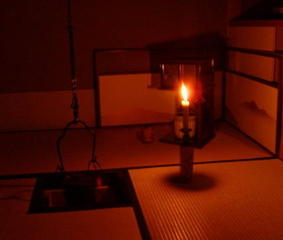There are several kinds of tea ceremonies held during the year depending on the time of the ceremony, the occasion for holding the tea ceremony and the current season.
- The Hatsugama 初釜, meaning “first kettle.” which happens in January
- This is a unique occasion being the only time that a tea teacher would serve tea and food for students.
1. Akatsuki-no-chaji / 暁の茶事 / Winter Tea Ceremony held at dawn
This tea ceremony is celebrated very early morning during winter 
2. Yuuzari-no-chaji (Yûzari-no-chaji) / 夕ざりの茶事 / Tea Ceremony held early in the evening (warm weather)
In contrast to the Akatsuki-no-chaji, the tea ceremony is held while daylight transforms to darkness helped only by candle light. This tea ceremony is held in the early evening during warm weather.
3. Sa-cha / 朝茶 / Tea Ceremony in the early morning during summer
These tea gatherings are celebrated during summer in the early morning.
4. Shoburo / 初風炉 / Using the portable brazier for the first time (May)
The Shoburo celebrates using of the Furo for the first time. In modern day calendar, this happens in May.
5. Shougo-no-chaji (Shôgo-no-chaji)/ 正午の茶事 / Mid-day Tea Ceremony
6. Kuchikiri-no-chaji / 口切の茶事 / Tea Ceremony honoring the opening of a new jar of tea
November, is when the Ro is used first to signal the onset of winter. A new jar of tea is opened. To celebrate, the jar’s seal with tea that had been harvested in spring is torn and the fresh tea is used . Kuchiriki refers to the opening of the jar by breaking the seal. The complete tea ceremony is known as chaji and is accompanied by Kiocha and usucha (meals)
Considered as tea’s New Year, fences and gutters are repaired, Tatami mats are replaced with new ones and sliding screen doors (Shoji) are papered anew. The tea occasion is held at noontime and lasts for 4 hours with thick and thin tea. This is the most formal tea ceremony in Japan and is also the standard for Japanese tea ceremony.
7. Nagori-no-chaji / 名残の茶事 / tea event to honor remaining stock before wintertime (October)
Towards the end of Autumn around the month of October, very little tea remains in the jar that was opened during the Kuchikiri ceremony.
8. Yobanashi / 夜咄 / tea ceremony held in the evening during winter
This evening ceremony follows the Kuchikiri tea ceremony in honor of winter . The ceremony is performed at night in the tearoom lit only by candles.
9. Hatsugama / 初釜 /Tea Ceremony Celebrating first tea kettle boiling
Hatsugama is the sole occasion that a tea teacher prepares tea for his students. Usually,
this tea ceremony is a complete Chaji occasion following the whole ritual that is taught in class. It is considered a very special occasion.
II. History of the Japanese Tea Ceremony
III. Types of the Japanese Tea Ceremony
IV. Preparing tea
V. Equipment used during a tea ceremony (temae)
VI. Tea Ceremony Equipment for Guests
VII. Rank of Tea Ceremony Utensils
VIII. Room Preparation for tea ceremony